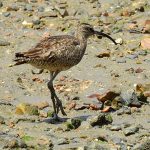WHIMBREL
SPECIES NAME
The Whimbrel is a fascinating bird with a distinctive presence, marked by its long, decurved bill which it uses adeptly to forage for food.
This medium-sized shorebird is part of the curlew family and holds a special place in the avian world due to its widespread migratory patterns and intriguing behaviors.
The Whimbrel is a true globetrotter and among the most impressive long-distance migrants. Some populations fly non-stop over the ocean for thousands of kilometers during their migrations.
During the breeding season, which occurs in the summer months, they are primarily found in the Arctic regions of North America and Eurasia. They prefer tundra landscapes where they can nest on the ground, often choosing spots with good visibility to keep an eye out for predators. As the breeding season concludes, the Whimbrel embarks on a remarkable migration to wintering grounds that are much warmer and located far south. In Australia, they are commonly spotted along the northern coasts, making use of the continent’s rich mudflats and estuaries from September to March before heading back north.
The Whimbrel’s long bill is not just for show; it’s a vital tool for their survival. They primarily feed on crabs, mollusks, and marine worms, which they skillfully extract from sand and mud with their specially adapted bills. Occasionally, they will also consume plant material. The tactile and visual experience of watching a Whimbrel foraging at low tide is quite remarkable, as they probe deeply into the sand, guided by touch and their sharp vision.
During the breeding season in the Arctic, the Whimbrel’s life is focused on reproduction. They typically lay four eggs, and both parents share the responsibilities of incubation. The nests are simple depressions on the ground, lined with bits of vegetation and strategically placed to provide a panoramic view of the surrounding landscape, which helps in spotting potential threats. They have a distinctive, trilling call that can be heard during the breeding season, serving both as a mating call and a territorial claim. The chicks are precocial, meaning they are relatively mature and mobile from the moment of hatching, which is vital for survival in the harsh Arctic environment.
Outside of the breeding season, Whimbrels can often be seen in large flocks, which helps provide safety in numbers from predators.
Whimbrels can live up to around 15 years, although life in the wild presents numerous challenges, including predation and habitat loss. They are considered a species of least concern by the International Union for Conservation of Nature (IUCN), but like many migratory species, they face threats from habitat degradation both in their breeding and wintering grounds. Conservation efforts are crucial to ensure that the habitats they rely on during their extensive migrations remain intact.
The Whimbrel is not just a bird; it’s a symbol of the interconnectedness of global ecosystems. Their annual migratory journey underscores the need for international cooperation in wildlife conservation and habitat protection. Watching a Whimbrel can be a profound reminder of nature’s intricacies and the resilience of life.



















